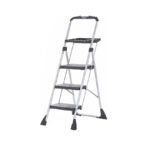The Best Ladders for Different Jobs
Are you tired of borrowing the neighbor’s ladder whenever you need to change the batteries on the fire alarm? In every house, at some point or another, the light bulbs, the artwork, and the gutters will need to be maintained or replaced.
On the other hand, you shouldn’t just grab the first ladder that you find. You risk purchasing one that is either inadequate for the job at hand, inadequate for your weight and the weight of the tools you are carrying, or both. Let’s discover the best ladder for various jobs around the house.
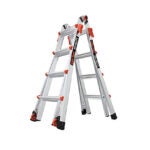
1. Little Giant Ladders 15417-001 – Editor's Choice
- Price range: $250 – $300
- Ladder type: multi-position
- Material: Aluminum
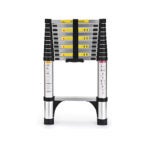
2. Soctone Store Telescoping Ladder
- Price range: $50 – $100
- Ladder type: telescoping
- Material: Aluminum
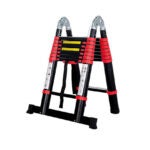
3. BEETRO Telescoping Ladder
- Price range: $150 – $200
- Ladder type: telescoping
- Material: stainless steel
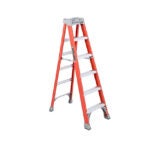
4. Louisville Step Ladder
- Price range: $50 – $300 (based on size)
- Ladder type: step
- Material: Fiberglass
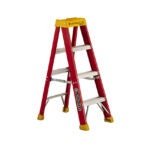
5. Louisville Ladder L-3016-04
- Price range: $50 – $500 (based on reach)
- Ladder type: step
- Material: Fiberglass
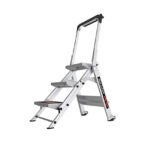
7. Little Giant Ladders 10310BA
- Price range: $150 – $200
- Ladder type: step
- Material: Aluminum
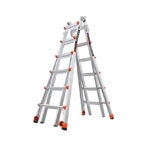
8. Little Giant Ladders 12026
- Price range: $500 – $600
- Ladder type: multi-position
- Material: Aluminum
Table Of Contents
- Our Picks for the Best Ladders
- 1. Little Giant Ladders 15417-001
- 2. Soctone Store Telescoping Ladder – Runner up
- 3. BEETRO Telescoping Ladder – Best telescoping ladder
- 4. Louisville Step Ladder – Best fiberglass ladder
- 5. Louisville Ladder L-3016-04 – Budget pick
- 6. Cosco Ladder – Best for quick indoor tasks
- 7. Little Giant Ladders 10310BA – Best step ladder
- 8. Little Giant Ladders 12026 – Best for roof work
- Frequently Asked Questions
Our Picks for the Best Ladders
You’ll find a mix of different types of ladders, their uses, and price ranges to help narrow down which one you need.
1. Little Giant Ladders 15417-001 – Editor's Choice
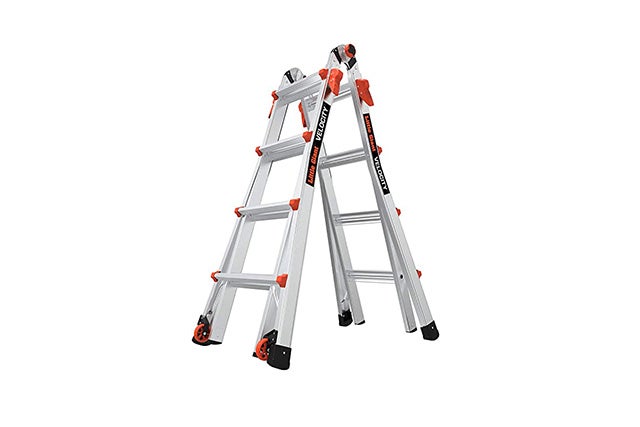
Highlights
- Price range: $250 – $300
- Ladder type: multi-position
- Material: Aluminum
Pros
- Good for homeowners and professionals alike.
- Easy to reconfigure.
- 300 pound weight capacity.
Cons
- Heavy and difficult to move around.
Probably one of the most versatile ladders on today’s list is this one by Little Giant. This is one ladder that can be used for various projects and is a great solution for homeowners who are limited in the amount of storage space they have but who require access to several kinds of ladders.
The user can securely set the ladder even when working on uneven ground thanks to the ratcheting leg levelers. The ladder can be folded down to a manageable size when it is not being used, and the wheels help you move it where it needs to go.
I’d say this is a perfect purchase if you need a ladder that works for doing multiple things around the house but is also fitting for a professional’s ladder arsenal.
2. Soctone Store Telescoping Ladder – Runner up
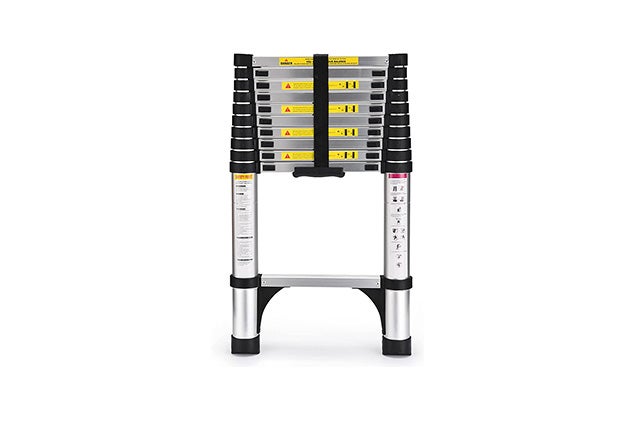
Highlights
- Price range: $50 – $100
- Ladder type: telescoping
- Material: Aluminum
Pros
- Supports up to 330 pounds in weight.
- Handle for easy carrying.
- Includes a storage strap.
Cons
- Doesn’t feel easy to maneuver.
Do you need a ladder for small repairs around the house? Then I believe this Soctone Store ladder is the perfect product for you! It works by extending each individual step, and you should hear an audio cue (like a click) when the step is in place. It has a very cool step locking and unlocking mechanism.
It’s lightweight and pretty portable compared to some of the other ladders in this article, which is always a plus because you don’t want to carry heavy stuff around. The triangle stabilizer makes you feel safe when you use it but make sure you never step on the top pedal because you will lose your balance.
3. BEETRO Telescoping Ladder – Best telescoping ladder

Highlights
- Price range: $150 – $200
- Ladder type: telescoping
- Material: stainless steel
Pros
- Safety lock mechanism.
- Non-slip caps.
- Prevents side-to-side rocking.
Cons
- Some users claim it needs more stability.
I would recommend the BEETRO ladder to anyone who needs a telescoping ladder that they can truly rely on. The ladder is not only constructed out of sturdy and high-quality stainless steel but also has a secure locking mechanism that prevents it from collapsing or becoming loose while climbing on it.
The non-slip caps have thick horizontal stripes carved into them, which significantly increases the friction between the ladder and the floor. Even on smoother surfaces like marble or ceramic tiles, climbing ladders is not difficult.
4. Louisville Step Ladder – Best fiberglass ladder
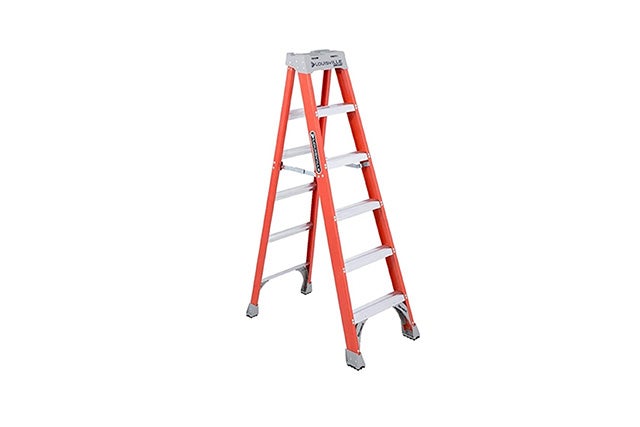
Highlights
- Price range: $50 – $300 (based on size)
- Ladder type: step
- Material: Fiberglass
Pros
- Protective spreader braces.
- Anti-slip feet.
- Multiple reach options.
Cons
- Some claim they received used ladders.
Let’s welcome one of the best fiberglass ladders for homeowners that money can buy. This ladder works for doing all sorts of indoor and outdoor work. So, whether you’re rearranging the pantry or trimming those apple trees, this ladder is there to serve you.
Spreader bracing installed inside fiberglass rails protects against the braces becoming hooked or abused while in transit. Double rivet step structure. Each step was reinforced with six large-headed, semi-tubular steel rivets to provide the highest possible level of stability. Maximal rigidity is provided by U-shaped back bracing installed vertically and separated at one-foot intervals.
5. Louisville Ladder L-3016-04 – Budget pick
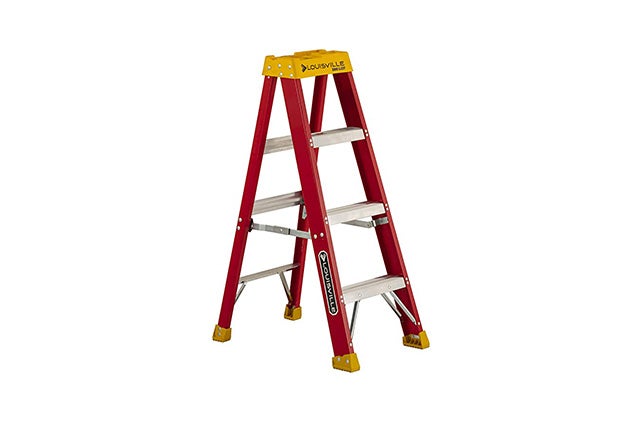
Highlights
- Price range: $50 – $500 (based on reach)
- Ladder type: step
- Material: Fiberglass
Pros
- Structural top for holding tools.
- Anti-slip rubber feet.
- 300-pound capacity.
Cons
- Some complaints about receiving used products.
When you’re short on cash, you can still get a good step ladder for repairs and renovations, and Louisville is here to ensure that. The step ladder from the Louisville L-3016 series has a duty rating of up to 300 pounds and allows you to secure your tools atop the ladder, thanks to the molded top that features handyman’s tool slots.
I’m particularly fond of this ladder’s vivid red color, which makes it visible and very difficult to trip over. The thick rubber feet will prevent you from scratching your hardwood floors while offering more stability on different surfaces.
6. Cosco Ladder – Best for quick indoor tasks
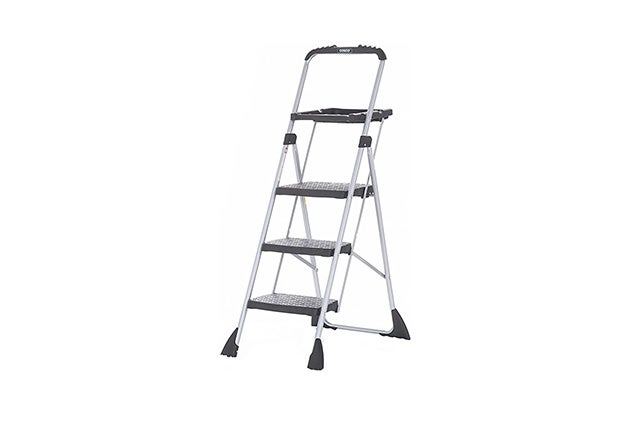
Highlights
- Price range: N/A
- Ladder type: step
- Material: steel alloy
Pros
- Material: steel alloy
- Easy to maneuver.
- Foldable and easy to store.
Cons
- Tends to slip on wooden floors.
This sturdy work platform can be used for a wide variety of large and minor chores around the house. It is also extremely adaptable. Whether you use it for washing windows, painting, or repairing, it will serve you well for a very long time.
It’s a pretty straightforward ladder that I recommend if you need to have one around the house for this and that. It can support up to 225 pounds in weight and comes with a tray to hold your working tools.
7. Little Giant Ladders 10310BA – Best step ladder
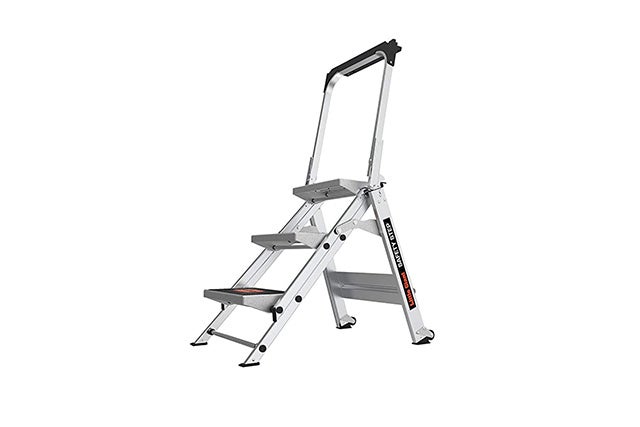
Highlights
- Price range: $150 – $200
- Ladder type: step
- Material: Aluminum
Pros
- Easy to manipulate.
- Compact and easy to store.
- Integrated work tray.
Cons
- Latches are difficult for one-handed operation.
Another great ladder for doing small chores around the house, like changing bulbs, fire alarm batteries, or getting stuff from the upper kitchen cabinets, is this one right here.
The Little Giant Ladder Systems Safety Step is a one-of-a-kind piece of equipment that combines robustness and ease of use. Aluminum of aerospace grade, which is both extremely robust and lightweight, is used in the construction of the Safety Step. You will experience unrivaled comfort and support because of the stairs’ generous width and anti-slip treatment.
8. Little Giant Ladders 12026 – Best for roof work

Highlights
- Price range: $500 – $600
- Ladder type: multi-position
- Material: Aluminum
Pros
- Very versatile.
- High weight capacity.
- Features plenty of useful accessories.
Cons
- It’s very heavy and difficult to maneuver.
Available in a 17, 22, and 26-foot version, this ladder is exactly the reliable product you want if you plan on doing any roof repairs. It has a high reach and can be used to set up Christmas decorations or get rid of ice dams. Due to its number of features and hefty price tag, this might be better suited in the hands of a professional, but I would recommend it to homeowners needing a tall and sturdy ladder.
Some of my favorite features include the cargo hold (so you can place your items nearby without having them get in the way), the work platform that’s easy to stand on when you’re working, and the wing span (so you can easily work around obstacles even when you’re up on the ladder).
How Do I Pick the Right Ladder for the Job?
Whenever you’re on a mission to pick the best product (regardless of category), some questions need answering to put you on the right path. To choose the best possible ladder, think about the following.
What Do I Need a Ladder For?
Since there is a diverse selection of ladders from which to pick, determining the kind of ladder that best suits your requirements and preferences is an essential stage in selecting the most appropriate product.
For example, a step ladder might suffice if you need a ladder around the house. A telescopic or an extension ladder might be more useful if you plan to do any outdoor repairs. Homeowners rarely need multi-function ladders, as they are most common amongst carpenters, electricians, or construction workers.
Am I Going to Do Any Roof Work?
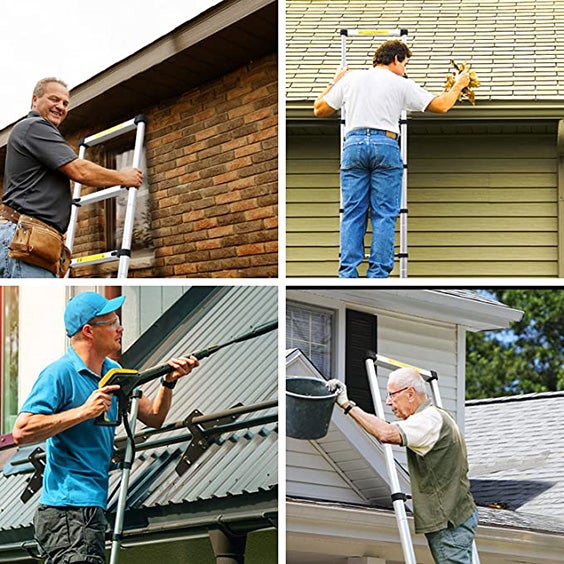
If you’re climbing on the roof for repairs, we need to change the ladder buying approach. If you are using the ladder for work outside, you should look for a model that can stretch at least three feet higher than the roof’s peak.
A stepladder for reaching the top of the fridge won’t cut it if you want to get up on the house. The additional length of this ladder will make it simpler to ascend onto the ladder and descend from the ladder onto the roof.
How Much Do I Weigh?
The length is not the only consideration that needs to be made when using it to access regions or things located at a height that would otherwise be inaccessible to you without using a ladder. The ladder you choose needs to support your total body weight (and then some).
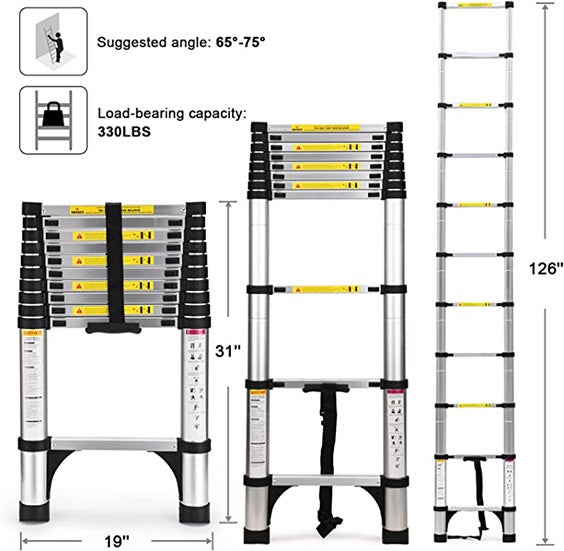
Most ladders can support about 200 pounds, while more professional ladders can support about 375 pounds. Always check the weight capacity of a ladder before you buy it and remember that you sometimes might have to take other stuff on the ladder with you (such as tools), so add that to the weight that needs to be supported.
Will I Be Moving the Ladder Around a Lot?
Knowing what you’ll be losing the ladder for will determine how maneuverable you need it to be. Old ladders were pretty sturdy due to their wooden construction, but it was not easy to move them around when needed. If you need a ladder that allows you to go up the roof and set up Christmas decorations once per year, then you don’t care about ease of maneuvering.
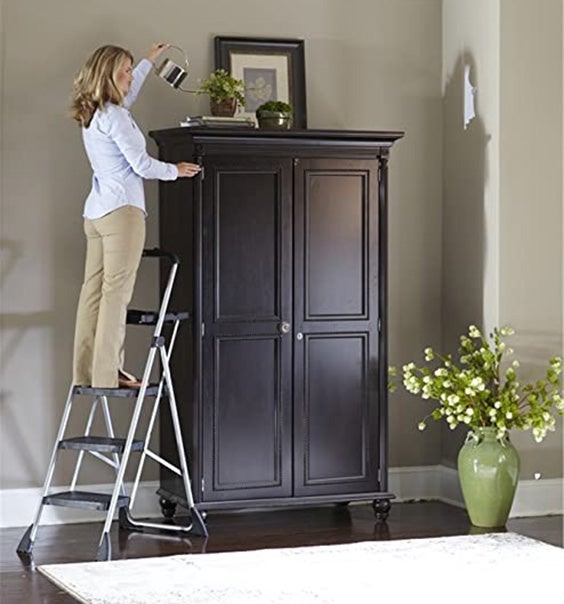
On the other hand, if you will be using a ladder regularly to reach high objects inside the house, trim trees outside the house, or maintain the gutter system, then it’s good to invest in a ladder that can be easily moved or repositioned.
Consider purchasing a telescoping ladder instead of an extension ladder since it offers the same height as an extension ladder but can be collapsed down into a more compact size, making it easier to move around.
Different Types of Ladders and Their Uses
— Step Ladder
A step ladder is the most compact sort of self-supporting ladder, and it can be placed on any surface that is level and does not slip. From the bottom to the highest point, it doesn’t reach more than 4 feet in height.
These folding and nonadjustable ladders are helpful for one-person jobs within the home that require only a little bit of extra height. Users can change light bulbs, access higher shelves, and clean more difficult-to-reach regions using step ladders. The user can ascend each step on most models, even the cap at the very top.
— A-Frame Ladder
Because of its height, an A-frame ladder is often considered the most suitable option for usage within the home. When standing on a level surface, an A-frame ladder’s height can range from 4 to 20 feet.
In homes with only one story, these ladders come in very handy for tasks such as replacing windows on the first level, installing ceiling fixtures, and cleaning gutters. Thanks to the hinged construction, they can be folded up and put away quickly. There are two distinct types of A-frame models available: front-step and twin-step.
A-frames with front stairs have a single rail that you can climb, and the steps themselves are flat and become progressively narrower as you move up the frame. Although it may be there, a back rail is not often climbable in most cases. Both the top cap and the step that is the furthest forward on the front rail are incapable of supporting a person’s weight.
A twin-step A-frame has rails on the front and back. Depending on the model, these stable ladders can simultaneously hold one or two persons.
— Telescoping Ladder
A telescoping ladder is more versatile because you can extend its reach and lock it into position. Depending on the model chosen, such a ladder can be between 8 and 12 feet long.
These ladders are normally made from aluminum or fiberglass and can weigh anything between 16 and 42 pounds. They don’t need a ton of space when folded, and they’re a great buy if you need a portable ladder that could fit in the trunk of your car.
— Multi-Position Ladder
The ideal type of multi-position ladder (also known as a multiuse ladder) has hinges that can be locked in various positions. These ladders are capable of transforming into a variety of configurations, and the wall can also support them. Multi-position ladders can reach heights of up to 30 feet, depending on the arrangement used.
Multi-position ladders, as their name suggests, are useful for doing several tasks around the house, some of which may require different ladders, while others may require more than one kind of ladder to complete successfully.
To paint a wall that runs along a staircase, for instance, the ladder might need to be propped up against the wall at the bottom of the staircase before being folded into an A-frame position on the stairs.
Check to see that the hinges can be unlocked, locked, and repositioned without climbing up or down. Attempting to make these adjustments while climbing a ladder is dangerous and should be avoided.
— Extending Ladder
Extension ladders have to be propped up against a structure such as a wall to be used safely. For maximum stability, they should be positioned to lean on the supporting structure at an angle of approximately 75.5 degrees.
When fully extended, an extension ladder can measure up to 72 feet in length, but it can be as little as 14 feet when folded. An extension ladder is made up of multiple pieces. They are great for outdoor tasks, including cleaning gutters or hanging outdoor decorations.
These ladders have either square or D-shaped rungs and are noticeably more condensed than those on step ladders and A-frame ladders. Users are strongly encouraged to wear footwear that offers adequate traction when ascending an extension ladder.
What to Look for in a Ladder
Material
The various types of ladders currently available on the market are usually made using one of three materials: wood, fiberglass, and aluminum.
Ladders made of wood are typically the most cost-effective option, even though they are heavy and may not last as long. When exposed to moisture and oxygen, wood rots and also acts as a conductor of electricity. Because of this, these ladders operate best indoors.
Fiberglass ladders, despite being heavier than those made of aluminum, are more durable and versatile. It can be used to construct a robust ladder. Because fiberglass is a nonconductive material, ladders made of fiberglass will serve their users well in electrical and non-electrical contexts. This kind of durability and adaptability typically results in a higher price tag than those made of wood or aluminum.
Aluminum is the material that weighs the least and has the lowest potential to corrode. Because this metal is one of the most efficient conductors of electricity, using aluminum ladders for any kind of electrical work or anywhere near power lines is not a good idea.
Weight Capacity
When you’re looking for a ladder, it’s important to know how much weight said ladder can hold. Ladders are divided into categories based on their load capacities, and here is what you should know:
- A type III ladder has a load capacity of 200 pounds.
- A type II ladder can support up to 225 pounds in weight.
- Type I ladders have a weight limit of 250 pounds.
- Type IA ladders support up to 300 pounds.
- For a 375-pound weight limit, look into type IAA ladders.
Height
When searching for a new ladder, one of the first things you should consider is the ladder’s height or reach. Remember that the ladder needs to be erected at an incline for the user to ascend the rungs without the risk of the ladder tumbling over.
This indicates that the length or height of the ladder needs to be more than the height of the roof for it to be safe to use. When utilizing a ladder, the optimal climbing angle should be somewhere between 70 to 75 degrees.
In addition, when the ladder is installed, it should reach at least three feet beyond the roof’s edge. This gives the user sufficient space to climb off or climb onto the ladder.
Weight
Simply put, moving a lightweight ladder is far less of a chore than moving a heavier one. One of the lightest solutions available is an aluminum ladder, with some models weighing as low as 20 pounds.
The fiberglass choices can weigh up to about 50 pounds each, meaning moving them might be difficult and require some muscle. Many larger, heavier step ladders and multi-position ladders have wheels to make them more portable.
Price
It’s not easy to find a cheap ladder of decent quality, but if you take care of it and keep it in good repair, these kinds of tools can endure for up to 20 years before you buy a new one.
Although the price range for single-section, extension, and telescoping ladders normally falls anywhere between $100 and $300, some heavy-duty models can be found that are more expensive than this range. The most expensive choice is a multi-function ladder, with some devices going for as much as $600.
Stepladders are substantially more compact than other common forms of ladders, which is one reason why these goods typically have lower prices. Depending on the specific length of the product, you can anticipate spending anywhere from $50 to $200 for a stepladder.
Safety Tips for Using a Ladder
When using a ladder, always keep your safety in mind by adhering to these fundamental guidelines:
- When ascending a ladder, wear shoes that won’t skid.
- Climb the ladder calmly and cautiously, avoiding any sudden movements or rocking from side to side as you go.
- You should not use an extension ladder when there are strong gusts, severe storms, or when it is damp outside.
- Place the ladder on even and solid ground. Avoid slopes, uneven or rocky terrain, puddles, or gravel.
- Don’t climb a ladder if any part of it is loose, damaged, or worn out.
- Don’t move a ladder when someone else is using it.
- Place your ladder so that it doesn’t obstruct doors or windows that could be opened while you’re using it.
- When you climb a ladder, your body should be positioned between the side rails.
- If you’re feeling sick or dizzy, avoid climbing a ladder.
- Don’t climb the ladder if you have muscle cramps.
- Avoid ladders when inebriated.
Final Thoughts
When an unexpected task requires you to work in a location that is difficult to access, having the appropriate ladder in your collection of home tools can spare you at least a couple of headaches.If you’re planning a home improvement project, such as painting a whole room or tearing it up, having a few ladders on hand will come in very handy. And add to your home tools arsenal with a water leak detector, we’ve got a list of the best!
Frequently Asked Questions
Ladders from Little Giant Ladders are very good for home use. You have plenty of different sizes and reach options to pick from, so you can easily find one for whatever tasks you want to perform around the house.
While there are plenty of ladder brands that you can rely on, Little Giant Ladder is definitely one that stands out.
There is no direct answer to this because it depends on what you plan to do with the ladder. It’s one thing to get a ladder for repairing the shingles on your roof and another thing to get a ladder to replace the lightbulb in the kitchen.
If we assume that your story is 8 feet tall, then the total height of a house with two stories is 16 feet. The same principle applies when calculating the height of 10 feet, which accounts for a ceiling height of 8 feet and a roof height of 2 feet. The height of a house with two stories is 20 feet. You need a 21-foot ladder for a 20-foot 2-story house.
It stands to reason that steel ladders are more long-lasting than aluminum ones, given that they are heavier overall. Because of its durability, steel is the material of choice for usage in industrial and commercial applications. You should consider purchasing steel if your ladder takes the brunt of the work.
Step ladders and A-frame ladders are considered to be more stable and safer, but there are rules on how to use them for proper safety (like never stand on the top step and always place them on an even surface).

